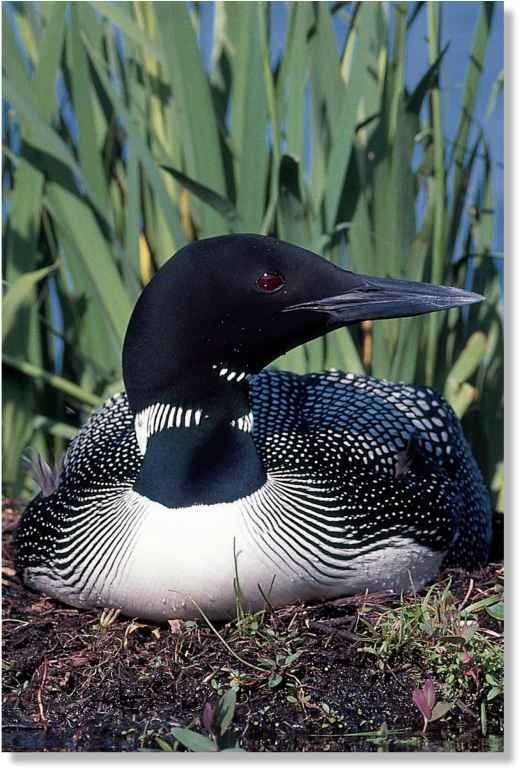ORDER
Gaviiformes
FAMILY
Gaviidae
GENUS & SPECIES
key features
• Has an evocative, haunting call (among the loudest of any bird) that can carry for long distances across water
• Can fish underwater for several minutes, propelled by strong legs and webbed feet
• Model parent that tends to its young closely; chicks are carried on a parent’s back or kept under a wing for warmth and protection
where in the world?
Breeds across northern North America, Iceland and Greenland; winters as far south as Florida and California; also occurs in western and northern Europe, occasionally nested in Scotland

Lifecycle
Sleek and exquisitely marked, the common loon haunts secluded lakes, announcing its presence with an eerie cry that travels far across its remote home.
HABITAT
A shy and highly aquatic bird, the common loon spends almost all its life on water This is mainly because it can barely walk on land (a characteristic of all loon species) due to the extreme rear placing of its legs on its body. In the breeding season (the short northern summer), it’s found on large, remote ponds and lakes in high latitudes of the Arctic tundra and northern North America. After breeding and before
winter sets in, the loon may migrate long distances, flying south to warmer ice-free waters, especially along coasts. It frequents the seas off rocky headlands and in sheltered bays. Migration across North America also brings it to inland waters; large numbers are in the Great Lakes area in spring and fall.
Great depths The common loon favors deep freshwater lakes.
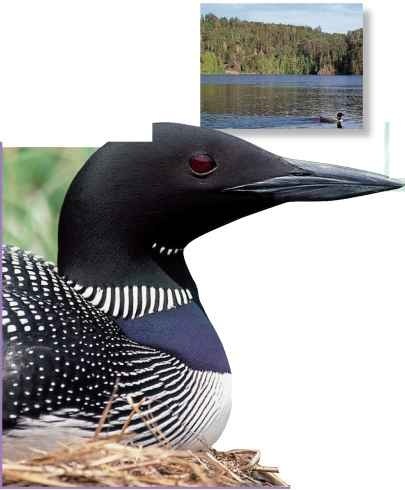
Wild at heart To outdoor enthusiasts, the common loon symbolizes the remote northern wilderness. Its preference for cool, remote lakes surrounded by tall pines and spruces contributes to its popular image.
BREEDING
As ice retreats from vast expanses of northern forest and tundra in spring, the loon returns to its breeding waters, occupying the same site year after year. Loons mate for life and are highly territorial, defending the nest against all intruders. Tiny offshore islets (a few feet across) are the usual site for nests; these offer protection from predators (raccoons and foxes) that steal eggs.
Both parents incubate the spotted eggs for about a month.The chicks, usually two, hatch covered with dark down. They leave the nest soon after hatching and are precocious swimmers and divers. But most of a chick’s early life is spent riding around on the back of one of its parents, nestled among the feathers for protection and warmth.
Although chicks can dive within a day of hatching, it takes up to six weeks for them to become efficient hunters, so the parents need to fish for them in the meantime. The adults train their chicks to catch prey by dropping captured fish in front of them.
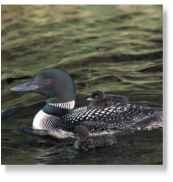
CONSERVATION
Although the common loon isn’t threatened, increased recreational use of lakes in the loon’s breeding range has had it serious impact on nesting success in some areas. Chemical pollution in the form of acid rain is also a danger. Acid rain is killing fish, destroying aquatic vegetation and acidifying lakes. And it’s not only in the breeding season that the loon is threatened: at sea in winter, it’s susceptible to oil spills.
BEHAVIOR
In the spring and early summer breeding season, loons make their presence known and defend their nesting territory with calls. The yodeling calls have a haunting quality that has been described like “maniacal laughter” For the rest of the year, the birds are silent.
Visual displays are also used to communicate. From mid-to late summer, loons hold ritualized ceremonies with their neighbors. One or both members of a mating pair will attend these gatherings.
Brief stay Loons leave the water only to clamber onto the nest.
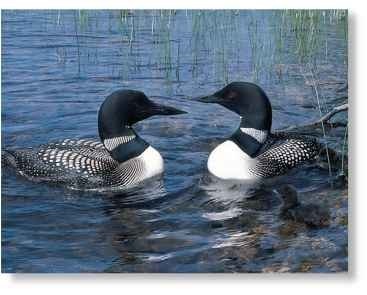
Diving board Chicks use their parents’ backs as a diving platform and ride on board for
safety and warmth.
A Togetherness Loon pairs form a strong, lifelong bond.
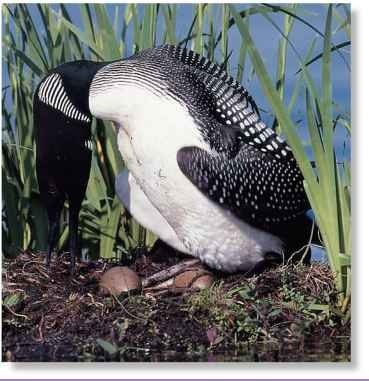
FOOD & HUNTING
The loon hunts fish, amphibians and aquatic invertebrates, such as mollusks and crustaceans, normally about 30′ below the surface. A typical foray underwater lasts for about one minute, although dives of up to eight minutes have been recorded and depths of over 230′ are occasionally reached.
The bird’s throat is expandable, letting it accommodate large fish. However, some loons have tried to swallow large flounders and the fish become wedged in their throat, causing the birds to suffocate.
DEADLY DIVE
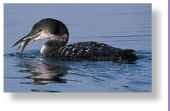
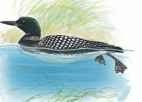
1 On patrol…
The loon cruises along, on the lookout for food. Sometimes it dips just its head under water to scan for prey.
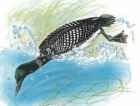
2 Dive…
Spotting fish, it flattens its plumage to expel air and make itself less buoyant, then plunges below the surface in pursuit.
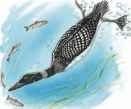
3 Paddle…
Taking up the the chase, the loon paddles rapidly with its feet. The wings are sometimes opened to help with steering.

4 Snap
Once in range of its quarry, the loon lunges forward, snapping at a fish to catch it sideways between the mandibles of its bill.
# The common loon is called the “loon,” because of the “lunatic” sounds of its wailing cries.
# In the breeding season, one family of common loons may consume nearly one ton of fish.
Profile
Common Loon
The common loon’s streamlined body is enhanced by legs set far back, providing great maneuverability and power on and under water.
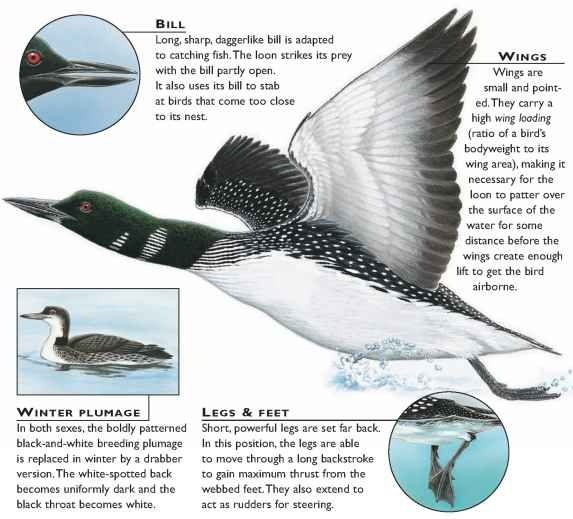
CREATURE COMPARISONS
Almost identical to the common loon, the yellow-billed loon is the largest of all loons at up to 14 lbs. It differs in its slightly upturned, ivory-
colored bill, which gives rise to its nickname of “banana-bill.” The smallest loon is the red-throated loon (only about 2 lbs). Being lighter than other
loons, the red-throated loon is able to take off directly from dry land. In breeding plumage, it is brownish with a scarlet throat-patch.

Yellow-billed loon
Red-throated loon
Common loon
| vital statistics | |
| Weight | 6-10 lbs. |
| Length | 27-36″ |
| Wingspan | 4-5′ |
| Sexual Maturity | 2 years |
| Breeding Season | May-July |
| Number of Eggs | usually 2 |
| Incubation Period | 25-30 days |
| Fledging Period | 12 weeks |
| Breeding Interval | 1 year |
| Typical Diet | Fish, mollusks, crustaceans, aquatic insects and vegetation |
| Lifespan | 8 years in wild; maybe 20 years in captivity |
Related species
• The common loon is one of five loons in the genus Gavia. The others are Pacific, red-throated,yellow-billed and Arctic loons. The common loon has two subspecies: G. immer immer and G. i. elasson. The Arctic loon has three subspecies: G. arctica arctica of Europe and Russia, I G. a. suschkini of Siberia and Asia and G. a. viridigularis of Siberia and Alaska.
